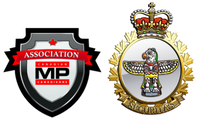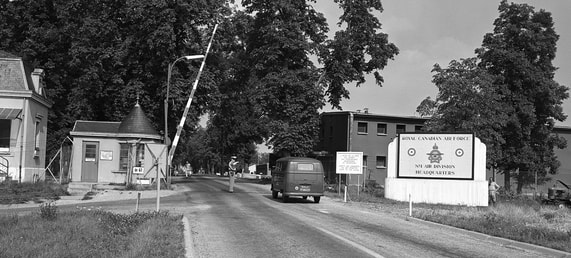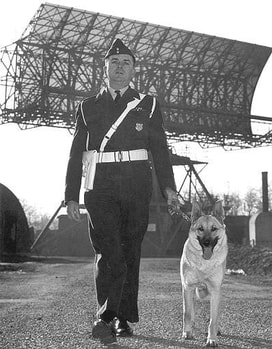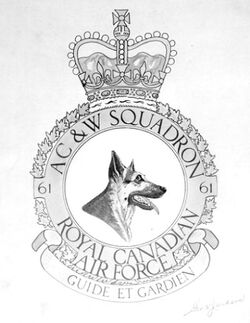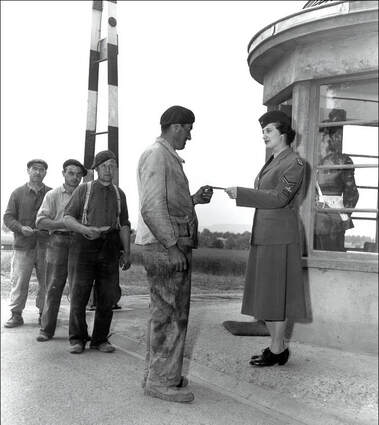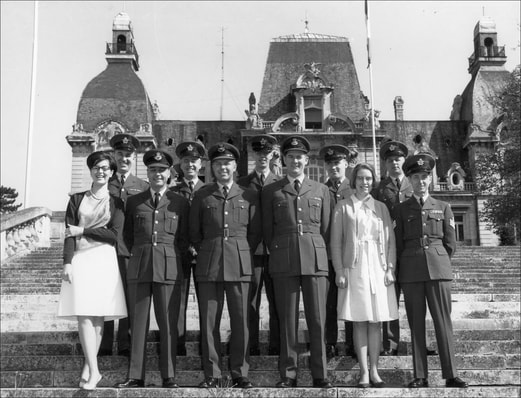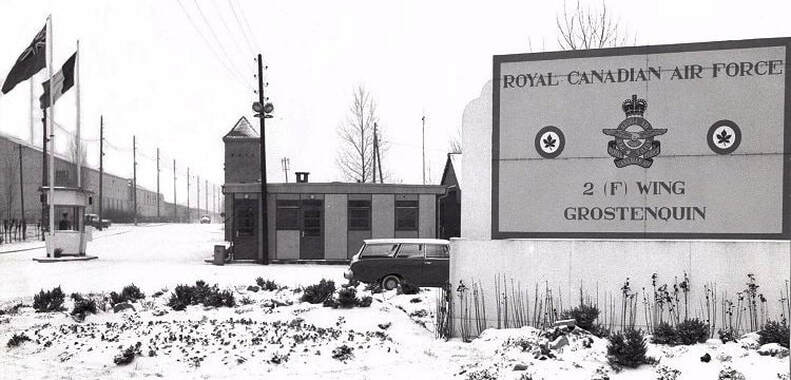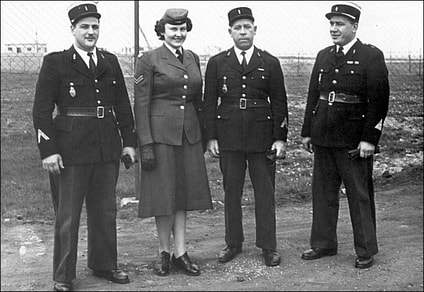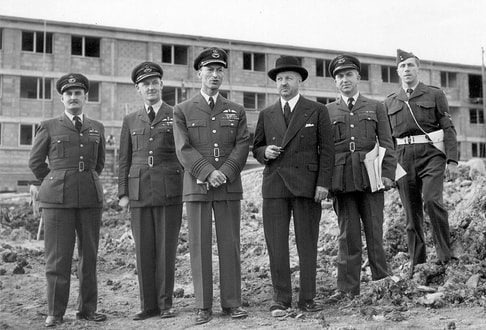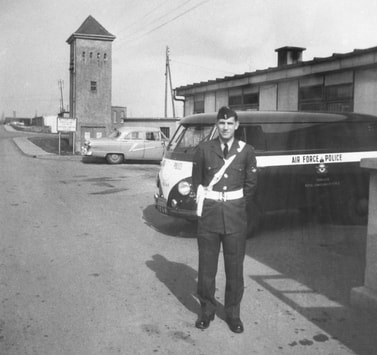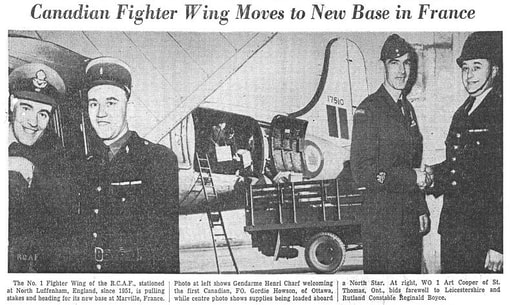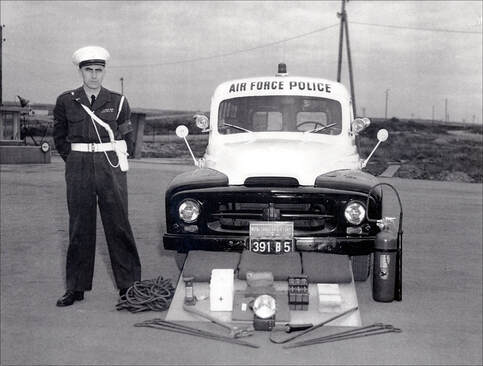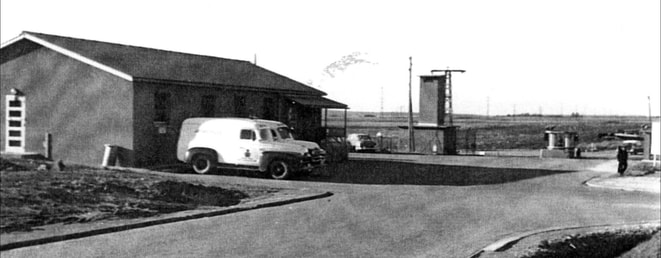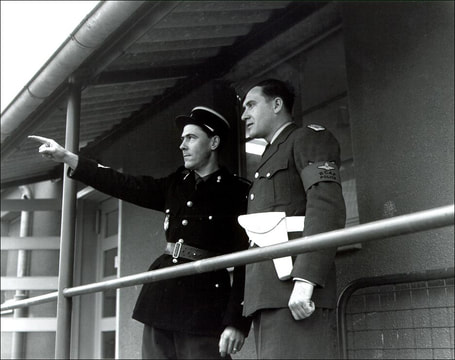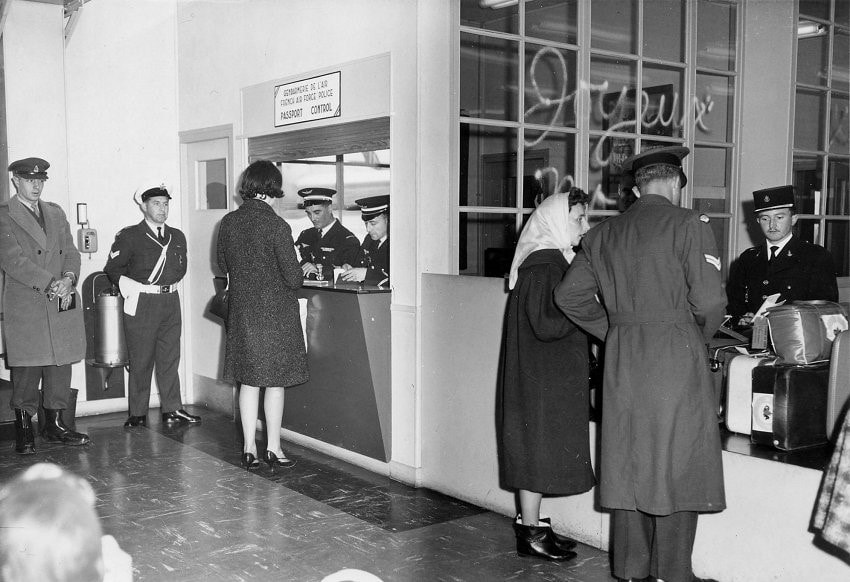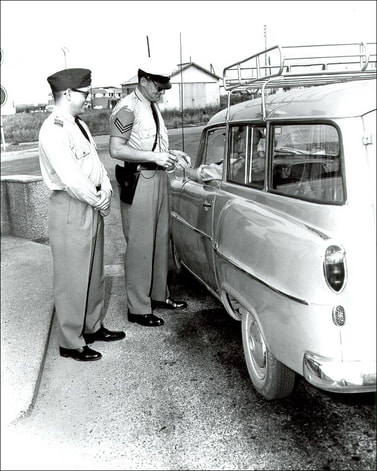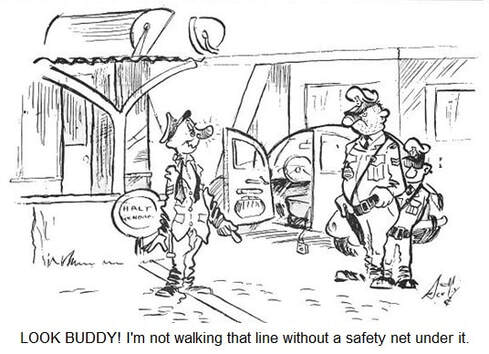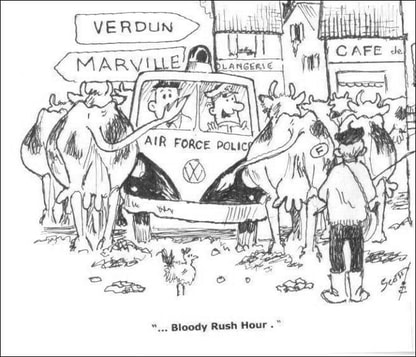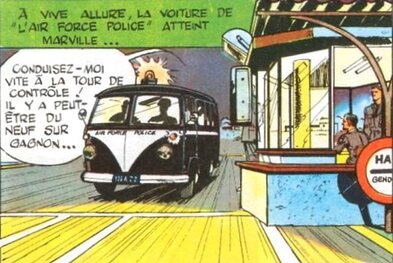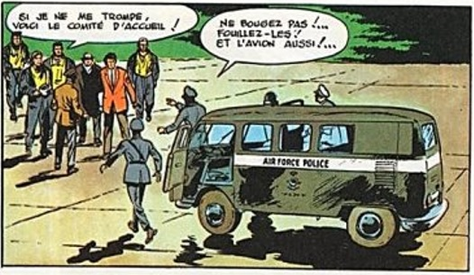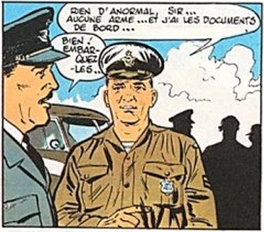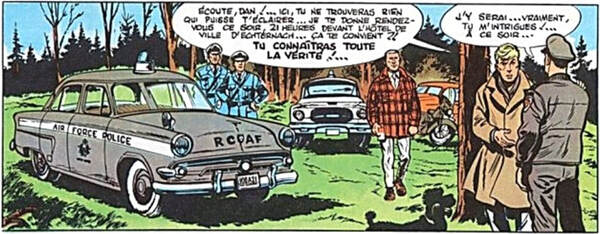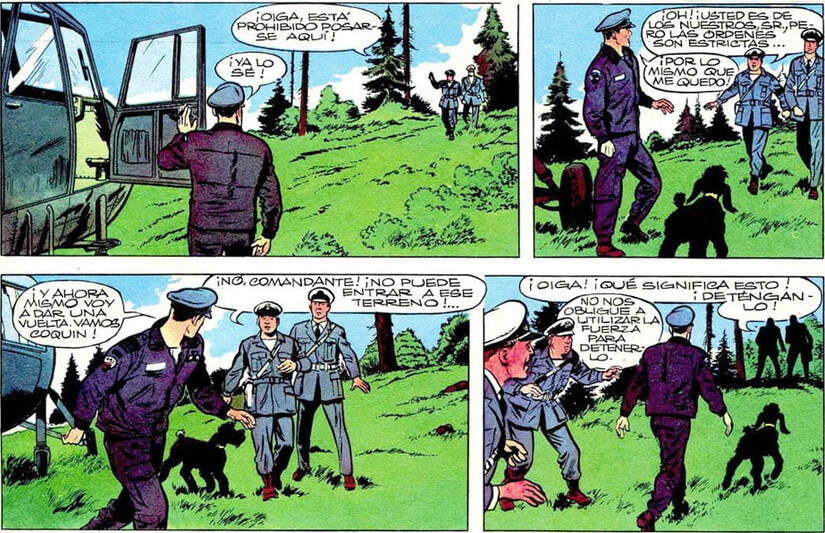Looking Back: Policing Canada's Air Bases in France
By Lieutenant-Colonel Paul Thobo-Carlsen (Retired), CMPA Director of History & Heritage
It is fairly well known that Canada operated several military bases in West Germany during the Cold War to help NATO deter and respond to potential Soviet aggression. However, it is less common knowledge that we also operated two air bases and several other units in France during the early stages of this protracted standoff between NATO and the communist Warsaw Pact bloc. Royal Canadian Air Force (RCAF) service police played an important role as part of Canada's NATO contribution in France.
|
No. 1 (RCAF) Air Division was created in October 1952 to coordinate Canada's air force component within NATO. Initially based in Paris, its headquarters was moved to Metz, France in April 1953. The Air Division was originally conceived to control two RCAF Fighter Wings in France (at Marville and Grostenquin) and two more in Germany (at Zweibrücken and Pferdsfeld). Metz, Marville and Grostenquin are all located in the historic Lorraine region in north-eastern France, adjacent to the borders with Germany and Luxembourg.
|
No. 1 (Fighter [F]) Wing initially operated from a temporary base in North Luffenham, England beginning in November 1951, but was working from its new home in Marville by March 1955. No. 2 (F) Wing began operating from the hastily built Grostenquin air base in October 1952. No. 3 (F) Wing started operations from its base in Zweibrücken, Germany in March 1953. Finally, No. 4 (F) Wing took over the former French airfield in Baden-Soellingen, Germany in September 1953 after construction delays prevented it from using the original Pferdsfeld location. Several other RCAF units were established in the Metz area, including the RCAF Support Unit, Combat Operations Centre, 61 Aircraft Control & Warning (AC&W) Squadron and 6 Tactical Aircraft Control Centre.[1]
In early 1952, the RCAF police organization began a series of changes that included a newly reorganized Directorate of Air Force Security at Canadian Forces Headquarters, an increase in establishment of 40 officers and 200 non-commissioned personnel, and a restructuring of the former Service Police mustering into a new Air Force Police (AFP) trade.[2] These changes were driven in part by the need to provide robust police and security support for the RCAF's new overseas NATO bases.
Metz
|
The 1 Air Div HQ in Metz initially included a Staff Officer Security (SO Secur) who was assisted by a Division Security Officer (Div Secur O) to coordinate security programs, a Division Provost Marshal (Div PM) to coordinate policing matters, two warrant officers, two non-commissioned officers and one clerk. The 1 Air Div security and police staff grew over time to three officers, one warrant officer, five NCOs and two clerks.
The first three staff officers assigned to this section were Squadron Leader (S/L) Francis Henry (SO Secur), Flight Lieutenant (F/L) Alf Laidler (Div Secur O), and Flying Officer Mickie LeSaulnier (Div PM). LeSaulnier was a former French national who was fluently bilingual. He proved to be a great asset in conducting liaison with the French authorities on many matters pertaining to security, policing and private motor vehicle licensing.[3]
|
A separate Air Force Police Section was formed under the Headquarters Administrative Unit (and later transferred to the RCAF Support Unit, Metz) to provide first-line police and security services to the headquarters staff and various other RCAF units located in the Metz area. Operating from a guardhouse beside the main gate, these AFPs controlled access to and patrolled the installation, provided physical and personnel security advice and services, and conducted police activities to help deter, detect and investigate crimes, services offences and traffic accidents.
In 1953, the complexity of certain criminal investigations and counter-intelligence activities within the 1 Air Div area of operations saw the attachment of two special investigators to the SO Secur staff: a Sergeant and a Corporal. This was later expanded to a stand-alone Special Investigation Detachment under the command of a commissioned RCAF Security Officer.[4]
Grostenquin
RCAF Station Grostenquin was the first Canadian flying base to operate in France—beginning in October 1952. Home to 2 (F) Wing, it initially comprised three squadrons of Canadair CL-13 (F-86 "Sabre Mk. V") day fighters along with the base support elements. In 1956, one of these flying squadrons was re-equipped with Avro CF-100 "Canuck" all-weather fighters.
Grostenquin was not an ideal location for an airfield due to its flood-prone topography, and the construction necessary to accommodate the Canadians was rushed in order to meet the NATO-imposed timeline to get the RCAF squadrons--with their state-of the-art Sabre Mk. V fighters--operating. Many buildings at the station were relatively flimsy pre-fabricated structures, and even those constructed on-site were made to building standards well below the Canadian norm. The early years in Grostenquin were marked by challenging working and living conditions, and lots of mud.
|
Flying Officer (F/O) Moe Labrosse was appointed as the first Wing Security Officer at Grostenquin.[5] With his previous wartime experience, Labrosse was very well suited to standing up an overseas service police section under trying conditions. The section was established for 42 all-ranks in 1952, and by 1958 had grown to 48 military personnel and one civilian employee.[6] The section included one dedicated position for a policewoman. The Air Force Police at Grostenquin were involved in typical garrison policing duties, combined with significant physical security responsibilities that included station access control. Traffic accident prevention and investigation was also a major AFP activity, particularly given the unfamiliarity by Canadian military personnel and dependents with European driving habits and narrow roads. Unfortunately, alcohol consumption contributed to many traffic accidents during this period.
|
RCAF Station Grostenquin eventually fell victim to international politics. In 1963, the flying squadrons at Grostenquin began receiving their new CF-104 "Starfighter" aircraft in preparation for a new nuclear strike role within NATO. However, President De Gaulle's government announced a new policy whereby all nuclear weapons on French soil would have to fall under its control. As this was unacceptable to Canada, the United States and the other NATO nations based in France, the Canadian government decided to relocate its planned nuclear strike capability to West Germany. Only conventionally armed and unarmed photo-reconnaissance versions of the CF-104 were flown from Grostenquin and Marville until their eventual closures. RCAF Station Grostenquin was officially deactivated on 1 August 1964, while Marville remained active for several more years as the main operating base for two CF-104 photo-reconnaissance squadrons.
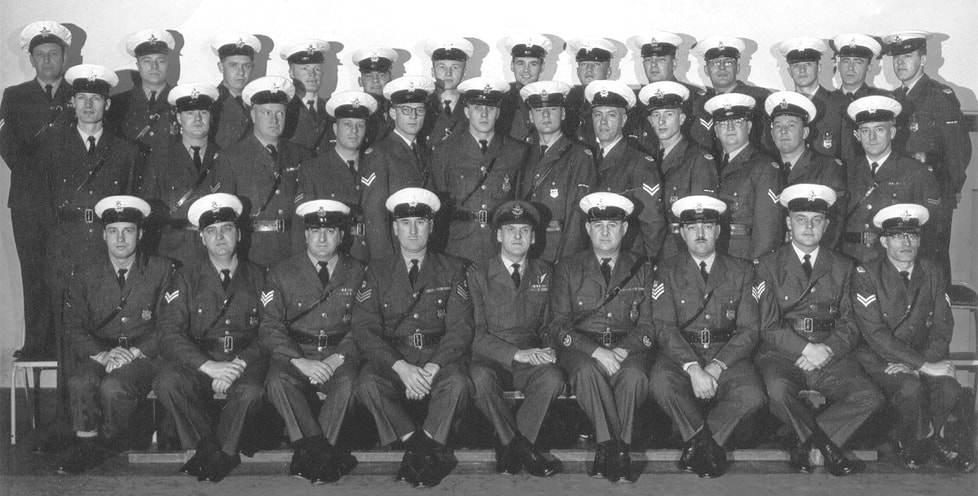
Last photograph of AFP personnel prior to the closure of RCAF Station Grostenquin, France, 1964. Back Row (L to R): Cpl Al Dunham, LAC Stan Bowers, LAC Ben Martens, LAC Roy Skillicorn, LAC Jack Villieux, LAC Al Belunick, LAC Pete Roughton, LAC Len Tschetter, Cpl Bill McRae, LAC Al Ruyzicki, LAC Doug Price, LAC Art Hall, LAC Claude Gagnon.
Centre Row: LAC Tex Lammle, LAC Jim Gugnet, Cpl Don Palmeteer, Cpl Charlie Sheppard, Cpl Dave Johnson, LAC Ray Calver, LAC George Kendra, Cpl Tony Bryant, LAC Perry Whittle, Cpl Jack Welch, LAC Millner, Cpl Ron Surgenor. Front Row: LAC Joseph Montpetit, Cpl Ken Howell, Sgt Danny Lewins, FSgt Angus Cameron, F/L Victor J. Heyes (WSecurO), WO2 Murray Hartling, FSgt Norm Stevens, Sgt John Wylie, Cpl Harry Pownall. (Photo: DND)
Marville
|
RCAF 1 (F) Wing was the first major Canadian air formation to operate in Europe during the Cold War, but spent its first three and half years at RAF Station North Luffenham in England.[7] There the Royal Air Force Police provided general police and security services for the station, but the Canadian-occupied sector was supported by its own security section comprising Flying Officer G.R. Howson (an RCAF Security Officer), 21 RCAF policemen and 12 Air Ministry Constables provided by the host nation.
Like the other 1 Air Div fighter wings, 1 (F) Wing was designed to support the operations of three fighter squadrons. While its eventual base in France took much longer to complete than its sister station at Grostenquin, the infrastructure at RCAF Station Marville was superior in most respects.
The move to Marville required that Air Force Police numbers be significantly increased to provide the full range of airbase security and policing services. Marville also hosted 5 Air Movements Unit (5 AMU)—with all the extra air terminal security requirements which that entailed. By 1956, the section had reached a peak strength of 54 military members and one civilian employee.[8]
In Marville, as at Grostenquin and Metz, the main operational mission for the Air Force Police was the the protection of the air force community and the prevention of crime and services offences. They adhered to the philosophy espoused in the RCAF's Air Force Police Manual, that "success of the protective measures is not gauged by the offenders caught but by the absence of offences."[9] The AFPs were thus known for carrying out their duties with tact and diplomacy, and became a key enabler for the safe, secure and effective conduct of NATO air operations in France.
|
|
A detachment of French "Gendarmes de l'air" also provided support to the Marville air base.[10] The full nature of their role is unclear, but their duties are known to have included passport control at the 5 AMU air terminal and jointly investigating traffic accidents on base along with the AFPs.
An interesting story about Marville was provided by retired military policeman Doug Scott.[11] Doug was posted to Marville as an AFP in 1963, and when he arrived there was a German Shepherd dog attached to the Air Force Police Section. His name was Butch, and he was employed as a guard dog at the ammunition compound, which was located in a forested area a few kilometres from the air base. During the day Butch was kenneled next to the AFP Guardhouse, but at 4 p.m. each afternoon he accompanied the AFP assigned to guard the ammo dump and remained there for the next 16 hours (two 8-hour AFP shifts) until Armament Section staff arrived the following morning. Butch was let loose and patrolled the ammo compound area, and was trained to attack anything that approached or touched the fence. This apparently lead to the death of many local farm cats who strayed into the compound.
|
Doug was told that Butch had been a jump dog with a French Paratroop unit, and from them he was passed to the Canadian AFPs. Apparently, because of the recent Algerian troubles, a number of military ammo dumps in the area had been raided for weapons and that may have been why the Marville AFPs ended up with their guard dog. However, Doug recalls that Butch had a bad habit of attacking anyone who smelled of French cigarettes, so perhaps the Paratroops had a more pragmatic reason for giving him up to the Canadians. When the RCAF Sentry Dog Program was created at Canada's two nuclear-capable bases in Germany, the Marville AFPs tried to obtain rations and medical support for Butch but this was denied by 1 Air Div staff because he was not officially "on strength" with the RCAF. As a result, Butch never saw a vet and he ate scraps from the mess hall supplemented by field mice that he caught.
Doug spent many hours with Butch and remembers him as a great dog. However, not everyone shared this sentiment. During a visit to Marville by Prime Minister John Diefenbaker, the "powers to be" decided that Butch should patrol the area around the VIP Quarters where the PM was staying overnight. Because these quarters were near a mess hall where a stray cat hung out, Butch ended up barking all night and by 3 a.m., the Prime Minister's Aide arrived to demand "the bloody dog" be taken away so the PM could get some sleep!
|
Doug Scott spent many off-duty hours drawing cartoons under his Scotty pen name for Marville's station newspaper, the Arrowhead Tribune. A number of Doug's cartoons featured Air Force Police themes, although he happily satirized all aspects of military life in the paper's "On the Lighter Side" section.
Doug was not the only cartoonist to feature the Marville Air Force Police. Belgian illustrator Albert Weinberg penned a cartoon book series from 1954 to 2010 based on a fictitious RCAF (and later Canadian Armed Forces) test pilot, Major Dan Cooper. Because Weinberg created his character for a continental European audience, these comics have never been published in English. Some of the early "Dan Cooper" comics used RCAF Station Marville as a backdrop, and at least one edition prominently featured the station's Air Force Police. Below are some examples from the French-language edition of Dan Cooper 13 - Le mystère des soucoupes volantes (Les Éditions du Lombard: 1969).[12]
Wienberg's "Dan Cooper" comics were published in several other European languages, such as the following clip from the Spanish version of this same edition—also depicting the Marville AFPs in action.
Back to reality...
In 1966 the government of France made a further policy decision to withdraw itself from NATO's command structure and required that all NATO units either leave France or fall under its national military command. A deal was made for the RCAF to take over the former French Air Force base in Lahr, West Germany and plans were quickly made to relocate 1 (F) Wing and its two remaining CF-104 photo-reconnaissance squadrons to that location. By April 1967, except for a small rear party, 1 Wing had vacated Marville.[13]
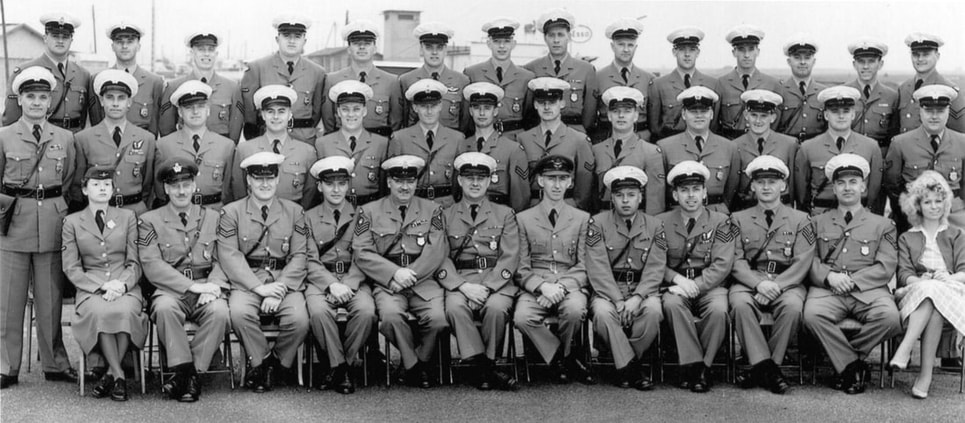
Air Force Police Section, RCAF Station Marville, France, May 1961.
Back Row (L to R): LAC Andy Bazinet, Cpl Ed Pullyblank, Cpl Paul Cornelius, LAC Andy Rathé, Cpl Bernie Mireault, Cpl Steve Kowal, LAC Buzz Rhinelander, Cpl Dick Philips, Cpl Ed Curray, LAC Danny McLean, Cpl Stew Blais, Cpl Buck Rogers, Cpl Dan Kendrick, Cpl Jack Shaw.
Centre Row: Cpl Syd Dryer, Cpl Ron Osborne, Cpl Greg Peck, LAC Smokey Halliwell, Cpl John Hogarth, Cpl Vern Hitchins, Cpl Lou Rochon, Cpl Larry Parrish, LAC Newt Lilly, LAC Cammy Cameron, LAC Dave Bruce, LAC John Zigarlic, Cpl Bert Sutherland.
Front Row: LAW Sylvia Wilson, Cpl George Larsen, Cpl Jack Gould, Sgt Dave Dale, FSgt Carl Hunt, WO2 Murray Hartling, F/L Pat Maloney-Chumney, FSgt Al Dubois, Sgt Mike Meehan, Sgt Ben Benoit, Cpl Ron Dee, Miss Janet (Photo: DND).
As the last RCAF fighter wing left France, so too did its higher headquarters. The remaining elements of 1 Air Division and the RCAF Support Unit vacated Metz by the end of March 1967, and the Air Div HQ began operating from its new location in Lahr as of 1 April.
The Air Force Police personnel who left France were quickly absorbed into other units in Canada and Germany, where the need for AFPs was at an all time high due the numbers required to provide security at the eight RCAF bases where nuclear weapons were being held. When the RCAF's era in France came to a close, its nuclear security era was already in full swing.
----------
Notes:
1. Those wishing to learn more about the RCAF's Cold War contributions in France may wish to visit the Military Communication and Electronics Museum website at c-and-e-museum.org/RCAF.html. Many photos related to the Air Force Police can be found there at:
- Marville: www.c-and-e-museum.org/marville/maps/buildings/build-49a.html and www.c-and-e-museum.org/marville/maps/buildings/build-49b.html; and
- Grostenquin: www.c-and-e-museum.org/grostenquin/maps/buildings/build-10.html and www.c-and-e-museum.org/grostenquin/maps/buildings/build-11.html.
2. Colonel (Retired) R. J. Donovan and Lieutenant-Colonel (Retired) D. V. McElrea, A History of the Royal Canadian Air Force Police and Security Services, (Renfrew, ON: General Store Publishing, 2008), 73-75. The new trade name initially adopted in 1952 to replace the old Service Police moniker was "Security Police," but in 1954 the trade name was changed again to Air Force Police.
3. Ibid, 127.
4. Ibid, 129. The first Special Investigation Detachment in support of 1 Air Div comprised F/O Fred Passmore, Sgt Ron Humphies and Cpl Jake Jacobson.
5. Ibid, 133. For more about the service police career of Moe Labrosse, see: www.cmpa-apmc.org/lb-moe-labrosse.html.
6. DND, Directorate of History & Heritage, file 181.005 (D159), Table of Organization and Establishment for 2 (F) Wing Grostenquin. The section's strength actually peaked to 54 all-ranks for one year in 1956, but went down slightly after that.
7. Another RCAF unit operated from the United Kingdom during this area, From 1953 to 1964, No. 30 Air Materiel Base (30 AMB) was located at RAF Station Langar in Nottinghamshire, and was responsible for providing logistical support to the various RCAF stations in France and Germany. 30 AMB included a Security Section led by an RCAF Security Officer and staffed by two AFP senior NCOs and three AFP corporals. Additionally, 18 Air Ministry Constables were employed in direct support to help man the RCAF access control points and conduct security checks.
8. DND, Directorate of History & Heritage, file 181.005 (D151), Table of Organization and Establishment for 1 (F) Wing Marville. The section's strength was subsequently reduced to 49 all-ranks in 1957.
9. DND, Directorate of History & Heritage, file 83/330, Canadian Air Publication 101, Air Force Police Manual (November 1956 edition), p. 15.
10. The Gendarmerie de l'air is a specialized department of the French Gendarmerie Nationale whose mission is the safety and security of air force installations.
11. Doug Scott created the military-themed Scotty cartoons. For more information on Doug's military career and artistic work, see: www.cmpa-apmc.org/looking-back-scotty.html.
12. Albert Wienberg, Dan Cooper 13 - Le mystère des soucoupes volantes (Les Éditions du Lombard: 1969). The full French-language comic can be viewed online at: www.c-and-e-museum.org/marville/articles/dacooper.html.
13. For more information about military policing in Lahr, see: www.cmpa-apmc.org/lb-lahr-military-police-section.html.
Notes:
1. Those wishing to learn more about the RCAF's Cold War contributions in France may wish to visit the Military Communication and Electronics Museum website at c-and-e-museum.org/RCAF.html. Many photos related to the Air Force Police can be found there at:
- Marville: www.c-and-e-museum.org/marville/maps/buildings/build-49a.html and www.c-and-e-museum.org/marville/maps/buildings/build-49b.html; and
- Grostenquin: www.c-and-e-museum.org/grostenquin/maps/buildings/build-10.html and www.c-and-e-museum.org/grostenquin/maps/buildings/build-11.html.
2. Colonel (Retired) R. J. Donovan and Lieutenant-Colonel (Retired) D. V. McElrea, A History of the Royal Canadian Air Force Police and Security Services, (Renfrew, ON: General Store Publishing, 2008), 73-75. The new trade name initially adopted in 1952 to replace the old Service Police moniker was "Security Police," but in 1954 the trade name was changed again to Air Force Police.
3. Ibid, 127.
4. Ibid, 129. The first Special Investigation Detachment in support of 1 Air Div comprised F/O Fred Passmore, Sgt Ron Humphies and Cpl Jake Jacobson.
5. Ibid, 133. For more about the service police career of Moe Labrosse, see: www.cmpa-apmc.org/lb-moe-labrosse.html.
6. DND, Directorate of History & Heritage, file 181.005 (D159), Table of Organization and Establishment for 2 (F) Wing Grostenquin. The section's strength actually peaked to 54 all-ranks for one year in 1956, but went down slightly after that.
7. Another RCAF unit operated from the United Kingdom during this area, From 1953 to 1964, No. 30 Air Materiel Base (30 AMB) was located at RAF Station Langar in Nottinghamshire, and was responsible for providing logistical support to the various RCAF stations in France and Germany. 30 AMB included a Security Section led by an RCAF Security Officer and staffed by two AFP senior NCOs and three AFP corporals. Additionally, 18 Air Ministry Constables were employed in direct support to help man the RCAF access control points and conduct security checks.
8. DND, Directorate of History & Heritage, file 181.005 (D151), Table of Organization and Establishment for 1 (F) Wing Marville. The section's strength was subsequently reduced to 49 all-ranks in 1957.
9. DND, Directorate of History & Heritage, file 83/330, Canadian Air Publication 101, Air Force Police Manual (November 1956 edition), p. 15.
10. The Gendarmerie de l'air is a specialized department of the French Gendarmerie Nationale whose mission is the safety and security of air force installations.
11. Doug Scott created the military-themed Scotty cartoons. For more information on Doug's military career and artistic work, see: www.cmpa-apmc.org/looking-back-scotty.html.
12. Albert Wienberg, Dan Cooper 13 - Le mystère des soucoupes volantes (Les Éditions du Lombard: 1969). The full French-language comic can be viewed online at: www.c-and-e-museum.org/marville/articles/dacooper.html.
13. For more information about military policing in Lahr, see: www.cmpa-apmc.org/lb-lahr-military-police-section.html.
